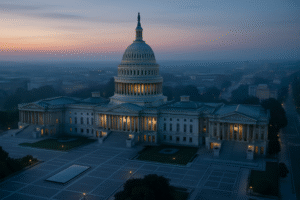Duration & Credit Pulse
Executive Summary
Bottom Line: A blockbuster December jobs report and hawkish Fed minutes from earlier in the week drove Treasury yields to extreme levels (99th percentiles), as markets priced peak uncertainty about Trump policies and monetary policy normalization. The labor market's resilience, combined with Federal Reserve concerns about Trump's inflationary policies, created the perfect storm for the bond selloff.
Duration Dashboard
| Maturity | January 3, 2025 | January 10, 2025 | Weekly Δ | 5-Year Percentile |
|---|---|---|---|---|
| 2‑Year | 4.28% | 4.38% | +10 bp | 74th %ile (elevated) |
| 5‑Year | 4.41% | 4.58% | +16 bp | 96th %ile (extreme) |
| 10‑Year | 4.60% | 4.76% | +16 bp | 99th %ile (extreme) |
| 30‑Year | 4.81% | 4.95% | +13 bp | 99th %ile (extreme) |
The Treasury curve experienced a dramatic bear steepening driven by two key catalysts: hawkish Fed minutes released Wednesday and Friday's explosive jobs report. Long-end rates reached the 99th percentile as markets repriced Fed easing expectations and Trump policy risks. The 256,000 December payroll gain—far exceeding the 155,000 consensus—eliminated any remaining dovish Fed sentiment and reinforced concerns about sustained economic strength amid potential inflationary policies.
Credit Pulse
| Metric | January 3, 2025 | January 10, 2025 | Weekly Δ | 5-Year Percentile |
|---|---|---|---|---|
| IG OAS | 0.74 bp | 0.76 bp | +2 bp | 21st %ile (tight) |
| HY OAS | 2.79 bp | 2.76 bp | -3 bp | 14th %ile (tight) |
| VIX Index | 16.13 | 19.54 | +3.41 | 50th %ile (normal) |
Credit markets displayed remarkable resilience despite the Treasury rout, with spreads remaining at tight levels and the VIX rising only modestly to normal 50th percentile territory. This divergence suggests corporate credit fundamentals remain supportive despite concerns about duration risk. High-yield spreads at the 14th percentile reflect continued optimism about economic growth supporting credit quality, even as funding costs surge.
US Macroeconomic Assessment – Labor Market Strength Meets Policy Uncertainty
The December employment report delivered a decisive blow to dovish monetary policy expectations, with 256,000 jobs added versus 155,000 anticipated. The unemployment rate dropped to 4.1%, while wage growth remained elevated at 3.9% year-over-year. This robust labor market performance, following Wednesday's Fed minutes expressing concern about Trump's inflationary policy agenda, created a hawkish confluence that drove rates to historically extreme levels.
Federal Reserve positioning: December FOMC minutes revealed officials' mounting concern about potential Trump policies—including tariffs, mass deportation, and fiscal expansion—and their inflationary implications. The Fed's decision to slow rate cuts in 2025 to just two (down from four projected in September) now appears prescient given the employment strength. With the economy at or above full employment and policy uncertainty elevated, the Fed's January 28-29 meeting will likely cement a prolonged pause in the easing cycle.
Political economy implications: The labor market's resilience provides the incoming Trump administration flexibility to pursue aggressive trade and immigration policies without immediate economic contraction concerns. However, the bond market's reaction signals investor wariness about the fiscal consequences of proposed tax cuts and spending priorities, particularly given the strong underlying economic momentum that reduces the need for stimulus.
Federal Reserve Policy Outlook
Friday's employment report effectively eliminated market expectations for a January rate cut, with fed funds futures now pricing less than 5% probability of easing at the upcoming FOMC meeting. The combination of robust job growth, stable unemployment, and Fed officials' documented concerns about Trump policy risks creates a compelling case for an extended pause. Chair Powell's upcoming communications will be critical in managing market expectations about the pace and magnitude of future policy adjustments.
The Fed now faces a complex dual mandate calculation with unemployment at a 50-year low (4.1%) while inflation expectations remain anchored but vulnerable to policy shocks. The central bank's December projection of two rate cuts in 2025 appears optimistic given current labor market strength and the potential for fiscal and trade policy to reignite inflationary pressures. Markets are repricing towards a "higher for longer" environment that could persist well into 2025.
Week Ahead: Inflation Data and Inauguration Positioning
- December CPI release (Jan 15): The final inflation reading before Trump's inauguration will be crucial for market positioning. Any upside surprise could cement hawkish Fed expectations and drive yields even higher.
- Trump inauguration (Jan 20): Market focus will shift to early policy announcements regarding tariffs, immigration, and fiscal priorities. Executive orders on trade policy could trigger immediate market reactions.
- Treasury auction calendar: 3-year, 10-year, and 30-year auctions will test institutional demand at these elevated yield levels. Foreign central bank participation will be closely monitored for signs of dollar reserve diversification.
- Corporate earnings season: Financial sector results will provide insights into net interest margin benefits from higher rates while industrial companies may signal early impacts from policy uncertainty on capital investment plans.
US Economic Positioning and Global Context
The week's developments underscore the US economy's exceptional position relative to global peers, with robust employment growth occurring alongside elevated but manageable inflation. This strength provides the incoming administration significant policy flexibility but also creates challenges for monetary policy normalization. The bond market's repricing reflects recognition that the US economic expansion may be more durable than previously expected, reducing the urgency for monetary accommodation.
Dollar implications: Treasury yield levels in the 99th percentile support continued dollar strength, particularly as other major economies face growth headwinds. The Federal Reserve's hawkish pivot amid Trump policy uncertainty contrasts with dovish central banks in Europe and Asia, potentially extending the dollar's structural advantage in global asset allocation decisions.
Key Articles of the Week
-
Fed minutes January 2025: Slower pace ahead for rate cutsCNBCJanuary 8, 2025Read Article
-
US labor market exits 2024 with strong job gains, drop in unemployment rateReutersJanuary 10, 2025Read Article
-
U.S. adds 256,000 jobs, as Biden leaves Trump with a sturdy labor marketNBC NewsJanuary 10, 2025Read Article
-
Jobs report December 2024CNBCJanuary 10, 2025Read Article
-
December 2024 Jobs Report: 256,000 Jobs Added, A Strong Finish to the YearJ.P. MorganJanuary 10, 2025Read Article
-
Job growth skyrocketed in December, boosting one of the strongest labor markets in US historyCNN BusinessJanuary 10, 2025Read Article
-
Markets News, January 10, 2025: Stocks Plunge as Treasury Yields Surge After December Jobs ReportInvestopediaJanuary 10, 2025Read Article
-
The final jobs report for 2024 lands Friday. Here's what 2025 could mean for your jobCNN BusinessJanuary 9, 2025Read Article






